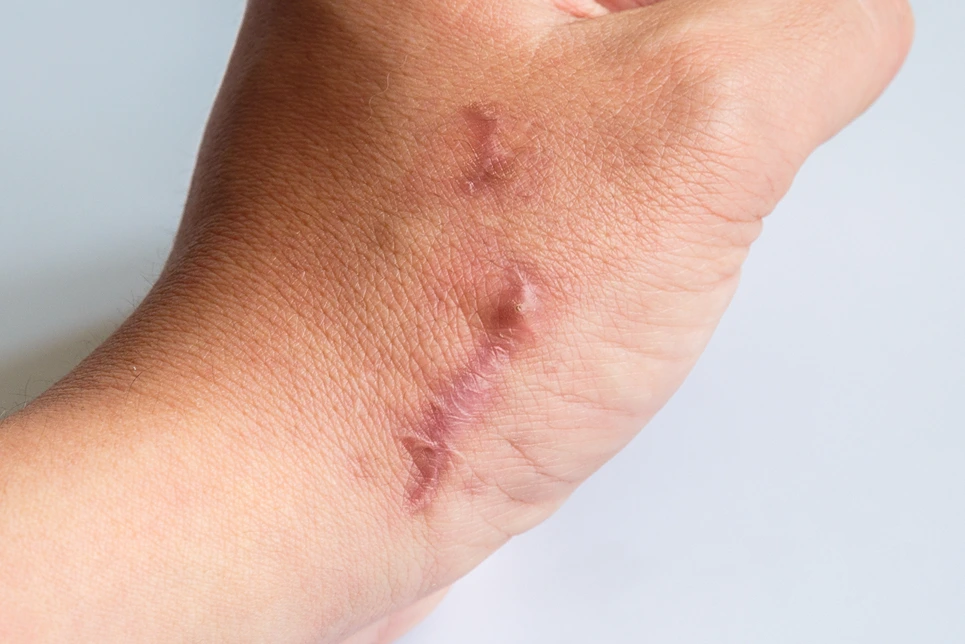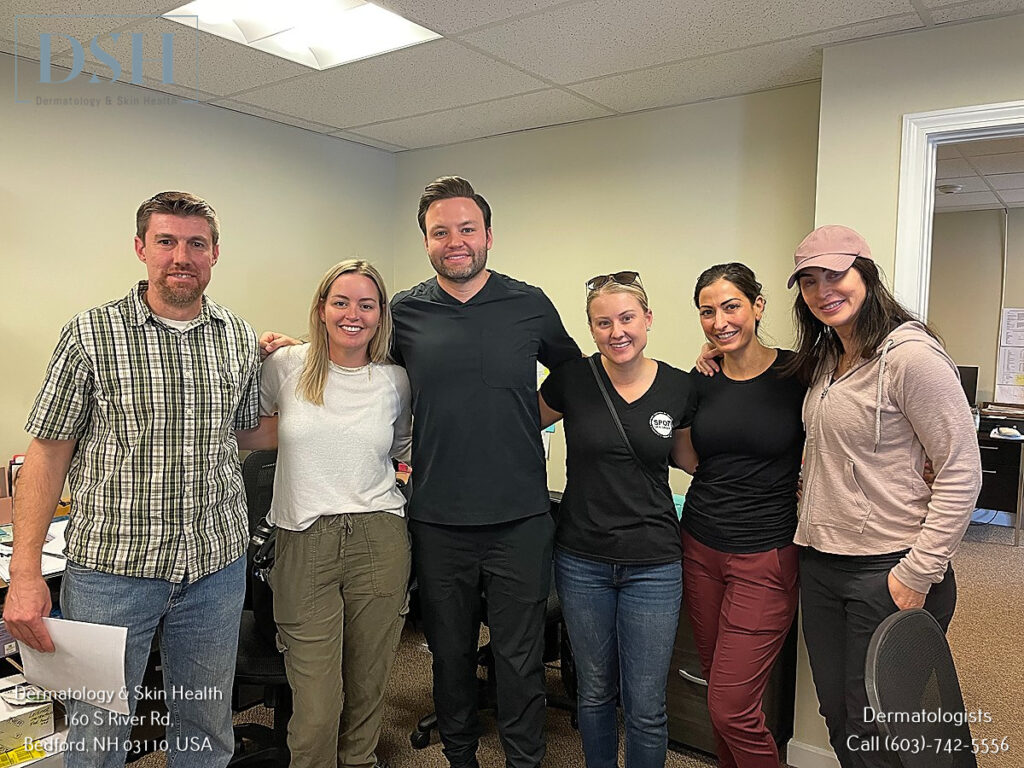


After Mohs surgery, some patients may experience a burning sensation as a temporary side effect. However, if this sensation persists for longer periods, it's advisable to consult a healthcare professional for further evaluation.
Mohs micrographic surgery is a specialized technique used to treat common types of skin cancer. During the procedure, thin layers of cancerous tissue are progressively removed and examined until only cancer-free tissue remains. This process helps preserve as much healthy tissue as possible.
While Mohs surgery boasts an incredibly high cure rate of up to 99%, the recovery process can bring some uncomfortable side effects like pain, swelling, and numbness. One common concern is a persistent burning or stinging sensation around the surgical site.
Here’s what you need to know about burning after Mohs surgery and how to find relief.
There are several potential reasons why you may experience a burning sensation during the recovery process after Mohs surgery:
One of the most common causes of burning is nerve damage that occurs during the surgical removal of skin cancer. Mohs surgery involves meticulously cutting away very thin layers of skin tissue until no cancer cells remain. However, this process can sometimes damage or sever tiny sensory nerves in the area. Disrupted nerve function can lead to numbness, tingling, pain or a distinct burning feeling.
After the surgery, it is normal for the area around the incision site to become inflamed and swollen as part of the natural healing process. However, this inflammation puts pressure on the surrounding nerves, which can provoke feelings of burning or pain. The severity of the burning often correlates with the degree of post-surgical swelling.
The surgical dressings, tape, antibiotic ointments and other bandages applied after the procedure can sometimes irritate sensitive skin and surgical wounds. This is especially true if a patient has an allergy or sensitivity to certain medical tapes, topical creams or other dressing materials. The irritation and inflammation of the skin caused by these products can lead to a burning sensation around the wound.
Mohs surgery performed on the lower legs, ankles and feet has a higher chance of causing painful nerve damage compared to other areas of the body. Therefore, procedures done on the lower extremities are more likely to result in bothersome burning feelings during recovery due to the increased risk of nerve trauma.
Certain antibiotics, pain medications or other drugs prescribed after surgery can potentially cause burning sensations as a side effect in some patients. Be sure to notify your doctor if you experience burning that seems linked to a particular medication.
Seek specialized care at Dermatology & Skin Health to understand and alleviate burning sensations post-Mohs surgery. Book your consultation today.

Mild burning and skin sensitivity around the surgery site is very common early on in recovery. Most patients find it resolves within a few weeks as swelling diminishes and nerves heal.
However, a small subset of patients experience persistent burning past 6 months or even 1 year later. This is more likely with larger procedures or surgery on the leg region. In most cases, the burning does still gradually improve during the year after Mohs surgery.
Experiencing burning, tenderness, or pain after Mohs surgery is common as the surgical site heals. There are several methods you can try to help reduce discomfort and find relief:
| 1 | Over-the-Counter Pain Medication | Your doctor may recommend taking OTC pain medications like acetaminophen (Tylenol) or ibuprofen (Advil) to help relieve pain and decrease inflammation. Follow dosage instructions carefully. |
| 2 | Ice Packs | Applying an ice pack or cold compress to the surgery site for 10-15 minutes at a time can help numb burning sensations and reduce swelling. Use a cloth between the ice and your skin. |
| 3 | Light Compression | Gently compressing the area with a soft bandage or dressing helps minimize inflammation. But avoid wrapping too tightly as this can restrict blood flow. |
| 4 | Oral Antihistamines | Antihistamine pills like cetirizine (Zyrtec) or loratadine (Claritin) can help calm skin irritation, itching, and inflammation that may be worsening burning. |
| 5 | Soothing Ointments | Lightly applying petroleum jelly, aloe vera gel, or over-the-counter hydrocortisone cream around the incision may provide cooling relief for some patients. |
| 6 | Sitting Upright | Avoid lying flat on the surgery site as this can increase blood flow and worsen burning. Sitting upright or propping your head with pillows can help. |
| 7 | Loose Clothing | Wear loose, breathable clothing that does not rub or irritate the affected area. |
| 8 | Avoid Heat | Heat can exacerbate post-surgical burning, so avoid hot showers, saunas, hot tubs, and direct sun exposure. |
| 9 | Distraction | Listening to music, reading, meditation, or other distracting activities can help take your mind off burning discomfort. |
| 10 | Time | Be patient as your skin heals. Burning and pain often gradually subside over several weeks or months post-surgery. Contact your doctor if symptoms persist. |
Talk to your dermatologist about the best options to manage discomfort after Mohs surgery based on your specific case. Report any severe or worsening burning, as additional treatment may be needed.

Mohs surgery requires some advance preparation to ensure you heal as comfortably as possible. Here are some tips to get ready:
Taking these preparatory steps will help you recover smoothly after your Mohs surgery. Be sure to follow any other directions from your dermatologist.
Trust Dermatology & Skin Health for comprehensive support pre- and post-Mohs surgery. Request an appointment now to ensure a comfortable recovery journey.
Dealing with scars after Mohs surgery can be an emotional journey. While scars are an unavoidable result of this skin cancer treatment, there are ways to help them heal optimally and reduce their visibility over time.
Here are some tips:
By caring for your wound properly in the months after Mohs surgery, you can minimize scarring and achieve the best cosmetic results. Ask your dermatologist for scar management recommendations specific to your case.

At Dermatology and Skin Health, Dr. Gary Mendese offers exceptional dermatological care, including skin cancer treatment and Mohs surgery. With offices across southern New Hampshire, we provide compassionate, customized care to meet your unique needs.
To learn more about Mohs surgery and recovering comfortably, request an appointment with Dr. Mendese online or call using the numbers below:
DOVER, NEWINGTON, LONDONDERRY, and BEDFORD offices - (603) 742-5556
PEABODY office - (978) 525-0100
Our team looks forward to helping you achieve healthy, vibrant skin!
If your desired appointment type or preferred provider is unavailable online, kindly call (978) 525-0100 for Peabody, MA and (603) 742-5556 for all New Hampshire locations. Alternatively please feel free to send us your request via the patient portal, or via email at info@dermskinhealth.com
*For medical dermatology appointments in MA please dial (978) 525-0100 or fill out the appointment request form above.